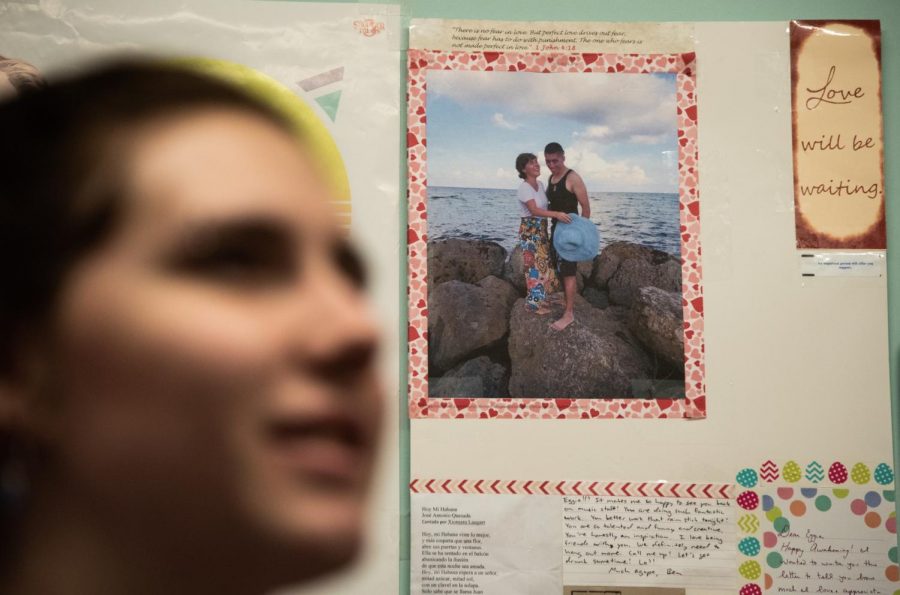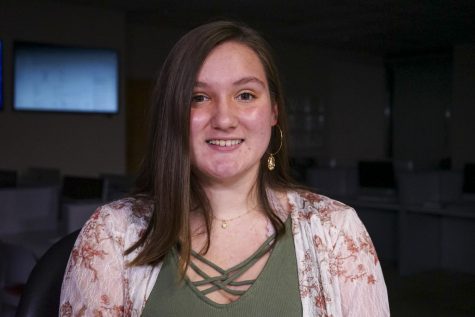Students try to make long-distance work
Emily Gil, English writing senior, looks at a photo of her and her boyfriend, who she has been with since May 2018. Gil met her boyfriend in her hometown of Miami and took their relationship long-distance when she moved back to New Orleans for the school year. Photo credit: Michael Bauer
February 14, 2020
Sophomore music education major Ava Coffin went into her freshman year dating her high school boyfriend. Originally from Washington, D.C., there were seven states between her and her then-boyfriend.
They had been friends for a long time and started dating toward the middle of her senior year.
“We didn’t really know if we were going to do it, and then there was one day where I was just like, ‘I want to do it. If you want to do it, we can, and if not, that’s fine.’ And he said ‘I want to do it, too,’” Coffin said.
They tried a few things: watching the same television shows, reading the same books, anything that they could do just as well apart as they did together, she said. However, he was still a senior in high school, so his life was pretty much the same while hers was changing.
“It’s really hard to sit down and understand if this is anxiety based off of me being in a new place or is this anxiety stemming from me being in a long-distance relationship,” Coffin said.
Ultimately, they broke up because of the distance. However, not all long-distance relationships end that way.
Seventy-five percent of college students have been in a long-distance relationship at some point, according to a study done by Dr. Li Crystal Jiang, a communications professor at the City University of Hong Kong, in 2013. The different experiences are reflected in the Loyola community.
“It was definitely better for me that we broke up. I couldn’t fully cope with being in a new city in a new place with new friends until I had to leave that part of home there and not take it here,” Coffin said.
English writing senior Emily “Eggie” Gil has been dating her boyfriend since May 2018. They met back in Miami, Florida, where she is from, and started dating with the intention of being a summer fling but said they had found something amazing.
“I did not plan to fall in love with him, nor did he plan to fall in love with me,” Gil said.
In order to hopefully avoid some of the issues of a long-distance relationship, Gil and her boyfriend decided to try an open relationship.
“Open relationships are when a couple decides that they don’t necessarily want to be monogamous, but it can be you’re emotionally open or physically open or both,” Gil said. “With us, it was more that we understood we had physical needs.”
There were rules to follow, and communication was key to understand that they both knew the intentions of their open relationship, Gil said.
“We knew we were each other’s number one,” Gil said.
They recently became exclusive, with Gil crediting that decision to their new focus on possibilities of a future together.
Regardless of whether they were exclusive or open, Gil emphasized communication. Besides both of them having busy schedules they needed to work around, Gil noted that she was not used to fully talking through an issue.
“A lot of my relationships ended with a miscommunication that ruins the spark,” Gil said. “My instinct is the whole flight or fight, and my instinct is to run away. But with him, he’s like ‘no, let’s fight for this.’ It’s shown me a new perspective, really.”
Caleb Cramer, music industry business freshman, has been dating his girlfriend for a year. They went to high school together in Massachusetts, but she is now in Canada, meaning there are over 2,000 miles between the two of them.
In their time apart, Cramer has really noticed the importance of communication, noting that he cannot rely on non-verbal cues to let him know if something is wrong.
“You have to really ask if everything is okay, like if you both are still okay, if the relationship is still okay,” Cramer said.
He said that there was a lot of pain and fighting, but that it made the moments that they spent together so much more worthwhile, that long-distance should be done with someone who is worth it.
“I flew up there for a few days last semester and seeing her in the airport was one of the happiest moments of my life,” Cramer said.








